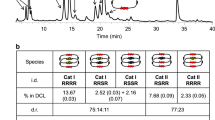Abstract
A mathematical model is presented for the kinetic resolution of racemates. It takes all intermediate binding steps into account and assumes that such steps are reversible. The model describing dynamics of the chiral reaction products consists of two nonlinear differential equations. With this model, the enantioselectivity of enzyme has been studied. Mathematical and numerical simulation of the model show that there are several ways to control the enantiomeric ratio (E) but the affinity and the binding rates of the intermediate enzyme complex to the racemic substrates are the key steps for the enzyme enantioselectivity.








Similar content being viewed by others
References
L. Keszthelyi, Q. Rev. Biophys. 28(4), 473 (1995)
D. Fitz, H. Reiner, K. Plankensteiner, B.M. Rode, Curr. Chem. Biol. 1, 41 (2007)
P.G.H. Sandars, Int. J. Astrobiol. 4(1), 49 (2005)
C.H. Senanayake, D. Krishnamurthy, I. Gallou, in Handbook of Chiral Chemicals, ed. by D. Ager (CRC Press, Boca Raton, FL, 2005)
B.S. Sekhon, Int. J. PharmTech. Res. 2(2), 1584 (2010)
W.J.M. Hegeman, R.W.P.M. Laane, Rev. Environ. Contam. Toxicol. 73, 85 (2002)
K.M.J. Brands, A.J. Davies, Chem. Rev. 106, 2711 (2006)
J. Bojarski, H.Y. Aboul-Enein, A. Ghanem, Curr. Anal. Chem. 1, 59 (2005)
K. Soai, T. Kawasaki, Top. Curr. Chem. 284, 1 (2008)
K. Soai, T. Kawasaki, Chem. Today 27(6), 3 (2009)
N.J. Turner, Curr. Opin. Chem. Biol. 8, 114 (2004)
J.A. Arcos, C.G. Hill Jr, C. Otero, Biotechnol. Bioeng. 73(2), 104 (2001)
W.R. Berendsen, G. Gendrot, S. Resnick, M. Reuss, J. Biotechnol. 121, 213 (2006)
J. Xiong, J. Wu, G. Xu, L. Yang, Chem. Eng. J. 138(1–3), 258 (2008)
G.D. Yadav, I.V. Borkar, Ind. Eng. Chem. Res. 47(10), 3358 (2008)
I.H. Segel, Enzyme Kinetics: Behavior and Analysis of Rapid Equilibrium and Steady-State Enzyme Systems (Wiley, New York, 1975)
X. Wang, W. Li, V. Kumar, J. Cell. Plast. 45, 353 (2009)
K.B. Taylor, Enzyme Kinetics and Mechanisms (Kluwer, Dordrecht, 2002), pp. 2–3
W.R. Berendsen, A. Lapin, M. Reuss, Chem. Eng. Sci. 62, 2375 (2007)
N. Yildirim, N. Ankaralioglu, D. Yildirim, F. Akcay, Appl. Math. Comput. 137(1), 67 (2003)
N. Yildirim, J. Math. Chem. 32(3), 271 (2002)
A. Aydemir, Modeling of Enzyme Catalyzed Racemic Reactions and Modification of Enantioselectivity, PhD. Thesis (Institut für Technische Chemie, Gottfried Wilhelm Leibniz Universität, 2010)
C.S. Chen, Y. Fujimoto, G. Girdaukas, C.J. Sih, J. Am. Chem. Soc. 104, 1294 (1982)
C.S. Chen, S.H. Wu, G. Girdaukas, C.J. Sih, J. Am. Chem. Soc. 109(9), 2812 (1987)
C.S. Chen, C.J. Sih, Angew. Chemie Int. Ed. Eng. 28(6), 695 (1989)
W.R. Berendsen, G. Gendrot, A. Freund, Biotechnol. Bioeng. 95(5), 883 (2006)
H. Hirata, G. Kondo, K. Kawauchi, Y.G. Chen, K. Sakaki, H. Yanagishta, J. Oleo. Sci. 55(5), 239 (2006)
S. Sahin, J. Warnå, P. Maki-Arvela, T. Salmi, D.Y. Murzin, J. Chem. Technol. Biotechnol. 85, 192 (2009)
Acknowledgments
We would like to thank Prof. Dr. Uwe Bornscheuer from Ernst Moritz Arndt Universität Greifswald for his comments and suggestions which measurably improved this paper
Author information
Authors and Affiliations
Corresponding author
Appendix: Derivation of the model equations
Appendix: Derivation of the model equations
The system of eight differential equations in Eqs. (2.4)–(2.11) and the mass conservation equations in Eqs. (2.1)–(2.3) describe dynamic evolution of the reaction network in Scheme 1. To simplify this model further, we assume that this system is at quasi-steady state and all the enzyme complexes stay constant over the course of the reaction. Therefore,
By solving Eq. (5.6) for [ELP], we get
where,
After plugging [ELP] into Eq. (5.5) and solving it for [ELS] gives
Here \(\alpha _4 \) and \(\alpha _5 \) are defined in terms of individual rate constants as,
From Eq. (5.4), [EDP] becomes
After substituting \([EDP]\) into Eq. (5.3) and solving it [EDS], we obtain
Solution of Eq. (5.1) for [EC] is
By solving Eq. (5.2) for [EE] after substituting [EC] in Eq. (5.15), [EDS] in Eq. (5.13) and [ELS] in Eq. (5.9), we get
Here \(\rho \) is a function of the substrate and the product concentrations, which has the following form
Here, \(\Theta _{\mathrm{i}}\)’s \((i=1\ldots 6)\) are defined as
After replacing \([EE]\) in Eq. (5.15) by Eqs. (5.17), (5.15) becomes
Substituting \([EE]\) in Eq. (5.17) into Eq. (5.13) gives
By substituting \([EE]\) in Eq. (5.17) into Eq. (5.9), we obtain
By plugging [ELS] in Eq. (5.22) into [ELP] in Eq. (5.7), we get
When we replace [EE] in Eq. (5.13) by [EE] given by Eq. (5.15), we obtain
Then substituting [EDS] in Eq. (5.24) into Eq. (5.11) gives us
Plugging [ELP], [EDP], [ELS], [EDS], [EE] and [EC] into the conservation equation for the enzyme given by Eq. (2.1), and then solving it for [E] we get
where,
From Eqs. (5.25), (5.26) and (2.10), rate of change for [DP] becomes
Here \(V_{\max 1}\) and \(V_{\max 2}\) are defined in terms of rate constants as
Finally, form Eqs. (5.23), (5.26) and (2.11), rate of change for [LP] becomes
Here \(V_{\max 3} \) and \(V_{\max 4} \) are given by
Rights and permissions
About this article
Cite this article
Aydemir, A., Yildirim, N., Hitzmann, B. et al. A new mathematical model for the enzymatic kinetic resolution of racemates. J Math Chem 51, 1532–1547 (2013). https://doi.org/10.1007/s10910-013-0162-7
Received:
Accepted:
Published:
Issue Date:
DOI: https://doi.org/10.1007/s10910-013-0162-7




